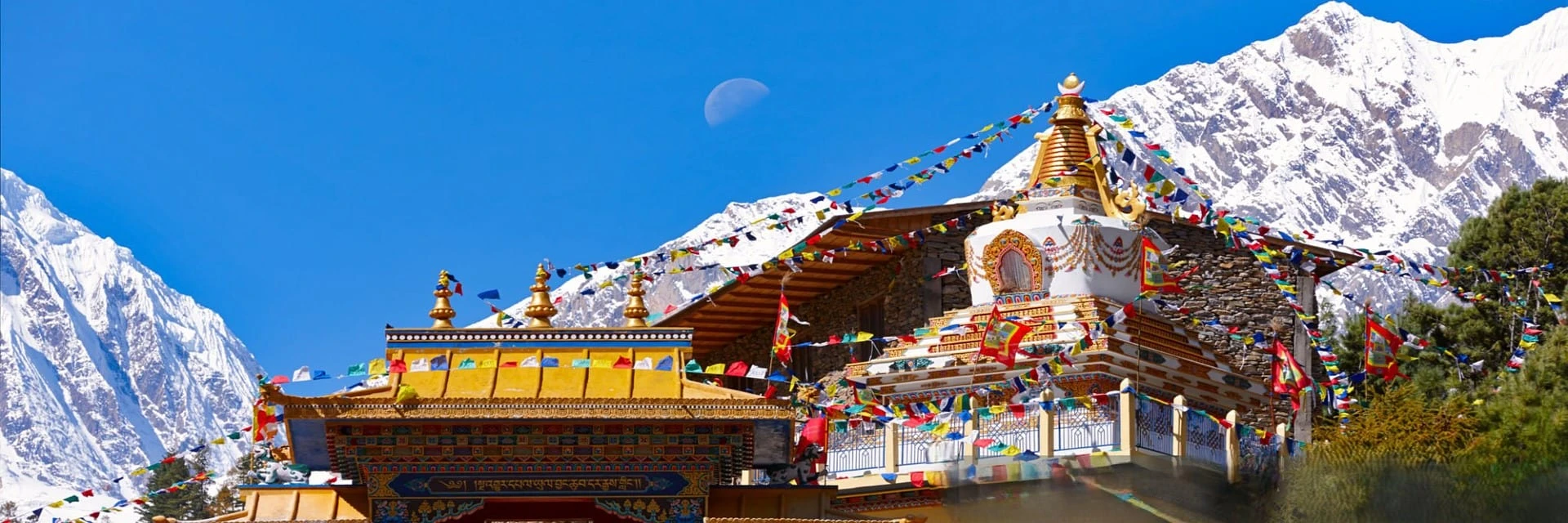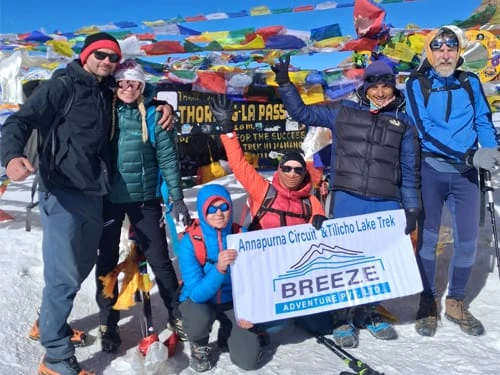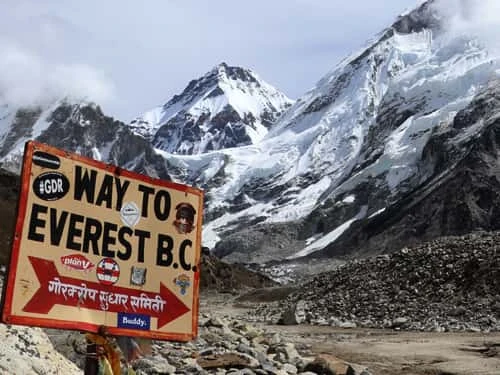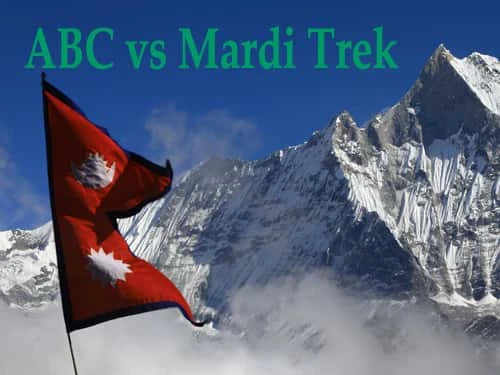History and Significance of Buddhism in the Manaslu Region
When you walk through the Manaslu area, you feel the air is not only cold and fresh but also full of stories. This region, especially the Nubri Valley and the Tsum Valley, has deep roots in Tibetan culture. Long ago, people crossed from Tibet, bringing their religion, their way of life, and their art. Monasteries grew as the center of it all.
For villagers, the gompa is not only a place to pray. It’s like a school, a meeting hall, a safe space. People go there for blessings before planting crops, ask monks to chant during funerals, and celebrate big festivals in the courtyards. The sound of long horns, drums, and chanting can be heard echoing across the hills during special days.
As a trekker, you see mani walls carved with prayers, stupas painted white and gold, and lines of prayer flags stretching across rivers. These are not decorations. They are everyday reminders of faith. Buddhism here is lived, not only practiced. That is why every monastery you pass feels so alive, even the small ones hidden in the forest or high on cliffs.
Cultural Experiences for Trekkers
At first, stepping into a monastery may feel intimidating. The ancient wooden doors, quiet interiors, and deep chanting create a powerful atmosphere. But if you're respectful—remove your shoes, speak softly—locals will welcome you with warmth.
Inside, the smell of incense is strong, butter lamps glow, and statues of Buddha or Guru Rinpoche sit tall. The walls are painted with colorful deities, some smiling, some fierce. You might see monks debating in loud voices; it’s their way of learning. In the morning or evening, the chanting begins. That low sound, mixed with drums and horns, goes straight into your bones.
During Losar, the Tibetan New Year, the villages become full of music and dancing. You may not understand the rituals, but you feel the happiness, the energy. Children run around, old people spin prayer wheels, and everyone joins together. Even simple moments, like sharing butter tea with a monk or nun, feel so special when you’re up in those mountains.
Manaslu's Major Monasteries
When you walk the Manaslu trail, you don’t just see mountains, rivers, and villages. You also meet something else very powerful. Buddhist sites on the Manaslu Trek stand quietly in stone, wood, and prayer flags. Some are big with hundreds of years of history.
Some are tiny, just a room with a shrine. But every single one feels alive. The sound of drums, the smell of incense, young monks laughing, old lamas praying, it all makes you stop and breathe a little slower. The monasteries that make this trek so special.
Pungyen Gompa
Pungyen Gompa is off the main trail; you walk maybe an hour or two from Sama Gaon. Yes, the path feels long, but once you reach it, everything opens. The whole Manaslu range stands right in front of your eyes, snowy, huge, and quiet.
Gompa itself is not some big fancy thing, just simple walls and a roof. But the place feels powerful. I sat there a long time, clouds moving, and no sound. People told me monks once stayed in caves around there, meditating in the cold. I believe it. The silence is heavy.
Sama Gompa
Sama gompa sits in the middle of Sama gaon. The village is big, busy with trekkers and yaks, but inside the gompa, it feels still silent. Statues of Guru Rinpoche, thangkas with old colors, and butter lamps are glowing all day.
It’s not only for monks; villagers gather there for puja, festivals, and even talk about small things. Once I heard long horns echo during prayers, a deep sound across the valley, it gave me chills.
Ribung Gompa (Lho Village)
Among the monasteries on the Manaslu Trek, Ribung Gompa is above Lho village. You can see the golden roof shining under the morning sun, with Manaslu standing huge behind. Young monks live there, many are kids, and they chant in the mornings. The sound carries through the village.
In the evenings, trekkers climb up, sunset paints the mountains orange and pink, and the gompa glows too. Those pictures will give you lifetime memories..
Kyimolung Monastery (Namrung)
Kyimolung monastery lies in Namrung, smaller than others but full of meaning. The walls have paintings of deities, with small rooms where monks sit to meditate. Namrung itself feels old, a trading village shaped by Buddhism.
Walking into the courtyard after a long day will relax you with the bells ringing softly with the wind, and everything slows down. Nothing special in look, maybe, but the peace inside stayed with you.
Pema Chholing Gompa (Prok Village)
Not every trekker goes to Prok, since it’s a little detour, but if you have time, you should. Pema Chholing Gompa is a hidden gem. It’s surrounded by forests, and when you enter, you feel the stillness.
The monastery is not very big, but the monks are friendly, and if you stay overnight in the village, you can join evening prayers. Many people say Prok and its gompa are highlights because they are so untouched by tourism.
Mu Gompa (Tsum Valley side trip)
If you add Tsum Valley to your trek, Mu Gompa is a must-visit place in the Manaslu region. It’s perched high, almost touching the clouds, at the far end of Tsum. The road up is steep and feels endless, but when you arrive, the sense of isolation and devotion hits you.
Mu Gompa has been home to monks for centuries. Even today, some monks live there all year, facing freezing winters with almost nothing. Inside, you find old scriptures, masks, and objects that survived hundreds of years. Many trekkers call it one of the most powerful monasteries in Nepal.
Rachen Nunnery (Tsum Valley)
While Mu Gompa is for monks, Rachen Nunnery is home for nuns. It is one of the few big nunneries in the region. The sight of dozens of women chanting, working, and smiling together is inspiring.
Rachen feels warm and welcoming. The nuns are kind; sometimes they invite visitors to sit and share tea. For trekkers, it’s a reminder that spirituality isn’t only about men in red robes, but also women carrying the same path with strength.
Kal Tal Gompa (near Kalchhuman Lake)
Few people know this monastery on the Manaslu Trek. Kal Tal Gompa lies near a small sacred lake called Kalchhuman or Kal Tal. It’s a hidden side trip from the main circuit, but locals say it’s very sacred.
Pilgrims sometimes come here during festivals to pray by the lake. The monastery itself is modest, but the setting, the lake, hills, and forest, make it feel like a natural temple. If you are the kind of trekker who loves off-the-beaten-path, this gompa is perfect.
Gumba Lungdang (Tsum Valley)
Another famous monastery in Tsum Valley, Gumba Lungdang, sits on a ridge with unbelievable views of Ganesh Himal. Mostly, it is run by nuns, and every evening they gather for chanting.
Trekkers who stay here overnight say it feels magical, the chanting, the fire in the kitchen, the cold mountain wind outside. Some even call it the best spiritual stop of the whole trek.
Hinang Gompa (near Sho Village)
Hinang Gompa is slightly off the main trail near Sho. It is surrounded by beautiful pine forests. This monastery is smaller but has a deep, quiet energy.
Locals often walk here for blessings, and monks give simple teachings to visitors. The hike up takes around 40 minutes, but its peacefulness is worth the effort. You can see mountain ranges stretching endlessly from here.
Other Small Monasteries and Shrines Along the Trail
The beauty of the Manaslu trek is that monasteries don’t come only in big names. Every village, like Deng, Shyala, and Samdo, has its small gompa or chorten. Even little stone houses with prayer wheels are part of the sacred map.
Sometimes you meet a lone monk living in a hut, offering a smile and a blessing, and a tiny shrine is hidden under a rock with butter lamps glowing. These places may not have names in guidebooks, but they touch trekkers deeply. So, the monasteries on the Manalsu trek are literally dreamy moments.
Walking Through a Living Museum
Visiting monasteries on the Manaslu trek is not just sightseeing; there are many sacred places in Manaslu, Nepal. It’s walking through a living museum of culture, faith, and survival. Each gompa has its own story. Some stand tall and proud, others are crumbling but still alive in spirit. Together, they create the heart of the trek.
These monasteries are the soul of the Manaslu Region. Without them, it would be just another mountain trail. With them, it becomes a pilgrimage, whether you’re Buddhist or not.
Spiritual Lessons from the Manaslu Monasteries
Most trekkers come for adventure. Also, for high passes, snow peaks, and challenges. But after visiting a few monasteries, many feel something shift inside. You learn to walk slower, to breathe with more care.
The prayer flags remind you of impermanence, how life, like the fabric, moves with the wind. The chants remind you of patience, because monks sit for hours, focusing on one thing. You start to see that trekking is not only about reaching a pass. It’s also about carrying lightness inside.
Personally, I think the monasteries give balance. When your legs are tired, cold, and far from home, sitting in a monastery brings peace. You don’t need to be Buddhist to feel it. Silence, prayer, mountains, together they calm the heart.
Practical Tips for Visiting Monasteries on the Manaslu Trek
If you are planning to see these monasteries, here are some things that help:
- Respect customs: Always remove shoes before entering. Walk clockwise around stupas and mani walls.
- Photography: Ask for permission. Some allow it; others do not.
- Keep quiet: Speak softly inside prayer halls and avoid disturbing rituals.
- Donations: Not mandatory, but appreciated. Even NPR 100–200 helps keep butter lamps burning and repairs going.
- Best seasons: Spring (March–May) and Autumn (September–November) are perfect for trekking and witnessing festivals.
- Local guides: They enhance your cultural experience and can translate local stories, making visits far more meaningful.
Carrying these small habits makes a big difference. Locals respect trekkers who show care for their culture.
Why Monasteries Make the Manaslu Trek Unique
Nepal has many iconic treks—Everest Base Camp, Annapurna Circuit, Langtang—but Manaslu stands apart. It’s wilder, quieter, and more spiritual. Unlike the more commercial routes, Manaslu's monasteries are lived-in, not just for show.
Here, spirituality and nature go hand in hand—you’re not just walking between mountains; you’re walking through centuries of culture, devotion, and deep Himalayan wisdom.
Conclusion
When I think back to my Manaslu trek, I do remember the snowy passes, the long climbs, and the wild rivers carving through deep valleys. But what truly stays with me—what echoes louder in memory—are the monasteries.
The early morning chants, the warm smiles of young nuns, the gentle spin of prayer wheels under my hand—these are the moments that gave the trek soul. These gompas are more than ancient structures made of stone and wood; they are the spiritual heartbeat of the Manaslu region.
Without them, the journey would be just another mountain trail. With them, it becomes a pilgrimage of the heart, even if you're not religious.
So, if you're planning a trek in Manaslu, Nepal, don’t just rush from tea house to tea house. Slow down. Step inside a monastery. Sit quietly. Watch. Listen. Let the sacred energy of these places guide you. You may descend from the mountains not only stronger, but also more peaceful than you ever expected.
Most Asked Queries: Monasteries on the Manaslu Trek
What monasteries can you visit on the Manaslu Circuit Trek?
During the Manaslu Circuit Trek, Trekkers can explore famous monasteries like Rachen Gompa, Mu Gompa, Pungyen Monastery, and Ribung Monastery in Lho. These gompas offer cultural insights and breathtaking Himalayan views.
Which is the oldest monastery on the Manaslu Trek?
The Ribung Monastery in Lho Village is considered one of the oldest along the Manaslu, showcasing centuries-old Tibetan Buddhist traditions.
Where is the famous Mu Gompa located on the Manaslu route?
Mu Gompa lies in the remote Tsum Valley, near the Tibetan border. At 3,700 meters, it is one of the largest and most isolated monasteries in the region.
Do trekkers need special permits to visit monasteries in the Manaslu region?
Yes. To trek and visit monasteries in Manaslu, you need a Manaslu Restricted Area Permit, Manaslu Conservation Area Permit (MCAP), and, if entering Tsum Valley, an additional Tsum Valley Permit.
What is the cultural significance of monasteries along the Manaslu?
These monasteries are the spiritual heart of Himalayan communities, preserving Tibetan Buddhism, ancient rituals, and cultural heritage in Nepal’s northern borderlands.
Can you stay overnight in monasteries during the trek?
Some monasteries, like Mu Gompa, occasionally offer basic shelter and food for trekkers, but most are for rituals and monks. Lodges nearby are more reliable.
How do Buddhist rituals and festivals influence the Manaslu trek experience?
Local festivals such as Losar (Tibetan New Year) bring monasteries alive with chants, dances, and prayers, offering trekkers a deep cultural immersion.
Are photography and videography allowed inside Manaslu monasteries?
Photography rules vary. In many monasteries, photography inside prayer halls is restricted, but outdoor shots of architecture and landscapes are usually allowed.
What are the top hidden monasteries trekkers should not miss on the Manaslu Circuit?
Hidden monasteries include Pungyen Monastery (with stunning Manaslu views), Rachen Gompa in Tsum Valley, and Ribung Monastery in Lho Village.
How do monasteries preserve Tibetan Buddhist traditions in the Manaslu region?
They serve as centers of meditation, education, and rituals, keeping Tibetan Buddhist scriptures, thangka paintings, and chanting traditions alive.
Which villages along the Manaslu Circuit have the most famous gompas?
Villages like Lho, Sama Gaon, Chhokang Paro, and Nile house some of the most famous monasteries that trekkers encounter.
What role do monasteries play in local life around the Manaslu Himalayas?
Monasteries guide religious life, community events, and education for local children, and act as centers of peace and spiritual learning.
Is there any monastery near the Lho Village on the Manaslu trek?
Yes, the Ribung Monastery in Lho Village is a highlight. It overlooks Mount Manaslu and offers a serene environment for both locals and trekkers.
How old are the monasteries found in the Manaslu region?
Many monasteries date back several centuries, reflecting Tibetan Buddhist influence from the 16th and 17th centuries.
What makes the monasteries of Manaslu unique compared to Everest or Annapurna?
Manaslu monasteries are less commercialized, offering a more authentic Tibetan Buddhist experience, with remote gompas and fewer crowds.
What is the role of monks and nuns in Manaslu’s monasteries?
Monks and nuns dedicate their lives to prayer, meditation, teaching Buddhism, and preserving ancient traditions, while also supporting their communities.
Are there any festivals celebrated inside monasteries along the Manaslu?
Yes. Monasteries celebrate Losar, Mani Rimdu, and Buddha Jayanti, where monks perform masked dances, rituals, and prayers.
How can trekkers respectfully visit monasteries on the Manaslu trail?
Visitors should remove shoes before entering, dress modestly, avoid loud noise, and ask before taking photos, ensuring respect for local customs.
Which monastery on the Manasl offers the best mountain views?
Pungyen Monastery near Sama Gaon offers spectacular views of Mount Manaslu and glaciers, making it a favorite among trekkers.
Do monasteries on the Manaslu Circuit allow meditation or prayer participation for trekkers?
Yes, some monasteries on Manaslu welcome trekkers to join meditation or morning prayers, providing a rare chance to experience authentic Himalayan spirituality.
Do I need a guide to visit monasteries in the Manaslu?
Not always, but a guide makes the experience richer. They explain history, rituals, and also help translate if you want to talk with monks or nuns.
Are donations expected at Manaslu's monasteries?
Yes. While not mandatory, donations are appreciated at monasteries on the Manaslu Trek. Contributions help maintain the gompas, support monks and nuns, and preserve Buddhist traditions. Trekkers usually offer a small amount in the donation box as a gesture of respect.
Do women also live in monasteries on Manaslu?
Yes. The Manaslu region has nunneries where women, called nuns, live and practice Buddhism. For example, Rachen Nunnery in Tsum Valley is home to many nuns who dedicate their lives to prayer, meditation, and spiritual learning.




